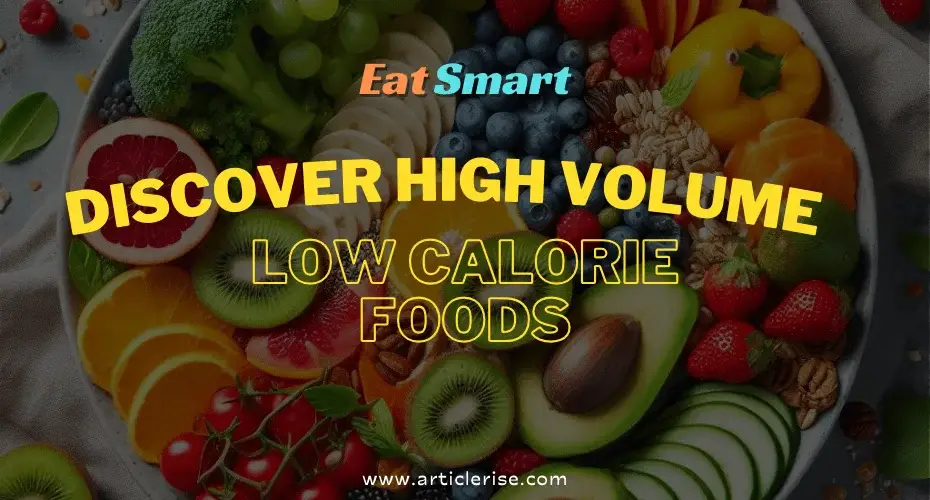High-volume, low-calorie foods offer many benefits that contribute to overall well-being. You can achieve satiety without compromising your calorie intake by incorporating these nutrient-rich options into your daily meals. Numerous delicious and satisfying choices exist, from fruits and vegetables to lean proteins and whole grains. Let’s delve deeper into the world of high-volume, low-calorie foods and uncover their secrets to a healthier lifestyle.
Understanding High Volume, Low-Calorie Foods
High-volume, low-calorie foods are defined by their ability to provide a large volume of food relative to their calorie content. This unique characteristic allows individuals to consume satisfying portions without exceeding their daily caloric needs. Such foods are typically rich in essential nutrients like vitamins, minerals, and fiber, promoting overall well-being.
Benefits of High Volume, Low Calorie Foods
Including high-volume, low-calorie foods in your diet provides numerous benefits. Firstly, they facilitate weight management by promoting satiety and reducing the likelihood of overeating. Additionally, these foods are nutrient-dense, ensuring that your body receives vital nutrients while keeping calorie intake in check.

Strategies for Integrating High-Volume, Low-Calorie Foods into Your Eating Plan
Integrating high-volume, low-calorie foods into your daily meals requires strategic planning. Consider meal prepping to have nutritious options readily available, practice portion control to avoid excessive calorie consumption, and explore substitutions and recipe modifications to enhance the nutritional profile of your favorite dishes.
High Volume, Low-Calorie Foods: Fruit and Vegetables
Fruits and vegetables are cornerstone components of a healthy diet, offering an array of vitamins, minerals, and antioxidants. Incorporate high-volume, low-calorie options such as cucumbers, berries, and leafy greens into your meals and snacks to boost nutrient intake while keeping calories in check.
High Volume, Low-Calorie Foods: Whole Grains
Whole grains provide sustained energy and essential nutrients, making them valuable additions to any diet. Opt for high-volume, low-calorie options like quinoa, bulgur, and barley to enhance the nutritional quality of your meals while promoting satiety.
High Volume, Low-Calorie Foods: Lean Proteins
Protein is crucial in muscle repair, and satiety is essential for overall health. Choose lean protein sources such as chicken breast, tofu, and fish to fuel your body while minimizing calorie intake.
High Volume, Low-Calorie Foods: Legumes and Pulses
Legumes and pulses are nutrient-rich sources of plant-based protein, fiber, and essential vitamins and minerals. Incorporate options like lentils, chickpeas, and black beans into soups, salads, and main dishes for a satisfying and nutritious meal.
High Volume, Low-Calorie Foods: Soups and Broths
Soups and broths are excellent for adding volume to meals while keeping calories low. Experiment with homemade recipes featuring vegetables, lean proteins, and whole grains to create flavorful and filling dishes.
High Volume, Low-Calorie Foods: Salads
Salads offer a versatile canvas for incorporating a variety of high-volume, low-calorie ingredients. Load up on leafy greens, colorful vegetables, lean proteins, and healthy fats to create satisfying meals or side dishes that nourish your body without excess calories.
High Volume, Low-Calorie Foods: Air-Popped Popcorn
Air-popped popcorn is a guilt-free snack that delivers crunch and flavor without adding significant calories. Enjoy it seasoned with herbs, spices, or nutritional yeast for a satisfying treat that won’t derail your diet.
High Volume, Low-Calorie Foods: Berries
Berries are nutritional powerhouses packed with antioxidants, fiber, and essential vitamins. Incorporate them into smoothies, yogurt bowls, or oatmeal for a refreshing and nutrient-dense addition to your diet.
High Volume, Low-Calorie Foods: Non-Starchy Vegetables
Non-starchy vegetables like broccoli, bell peppers, and cauliflower are low in calories but essential nutrients. Use them as the foundation for stir-fries, salads, and side dishes to increase volume and enhance nutritional content.
High Volume, Low-Calorie Foods: Seaweed
Seaweed is a nutrient-rich superfood known for its high iodine content and antioxidant properties. Experiment with nori sheets, kelp noodles, or seaweed snacks to add variety and nutritional value to your meals.
High Volume, Low-Calorie Foods: Zucchini Noodles (Zoodles)
Zucchini noodles, or zoodles, are a low-calorie alternative to traditional pasta, offering a lighter option for pasta lovers. Pair them with your favorite sauces and toppings for a satisfying vegetable meal.
High Volume, Low-Calorie Foods: Cottage Cheese
Cottage cheese is a versatile, protein-rich option that Individuals can enjoy independently or incorporate into sweet or savory dishes. Mix fresh fruit, nuts, or herbs for a nutritious snack or meal.
High Volume, Low-Calorie Foods: Cauliflower
Cauliflower is a versatile ingredient that can be transformed into various low-calorie dishes, including cauliflower rice, pizza crust, and mashed cauliflower. Explore different cooking methods and flavor combinations to discover new ways to enjoy this nutritious vegetable.

Conclusion
Incorporating high-volume, low-calorie foods into your diet is an innovative and sustainable approach to healthy eating. By prioritizing nutrient-dense options like fruits, vegetables, whole grains, and lean proteins, you can nourish your body while managing your weight and supporting overall well-being. Embrace the diversity of these foods and experiment with new recipes to discover delicious and satisfying ways to eat smart and thrive.







